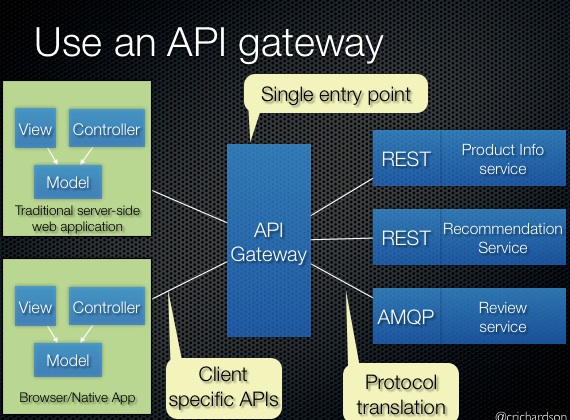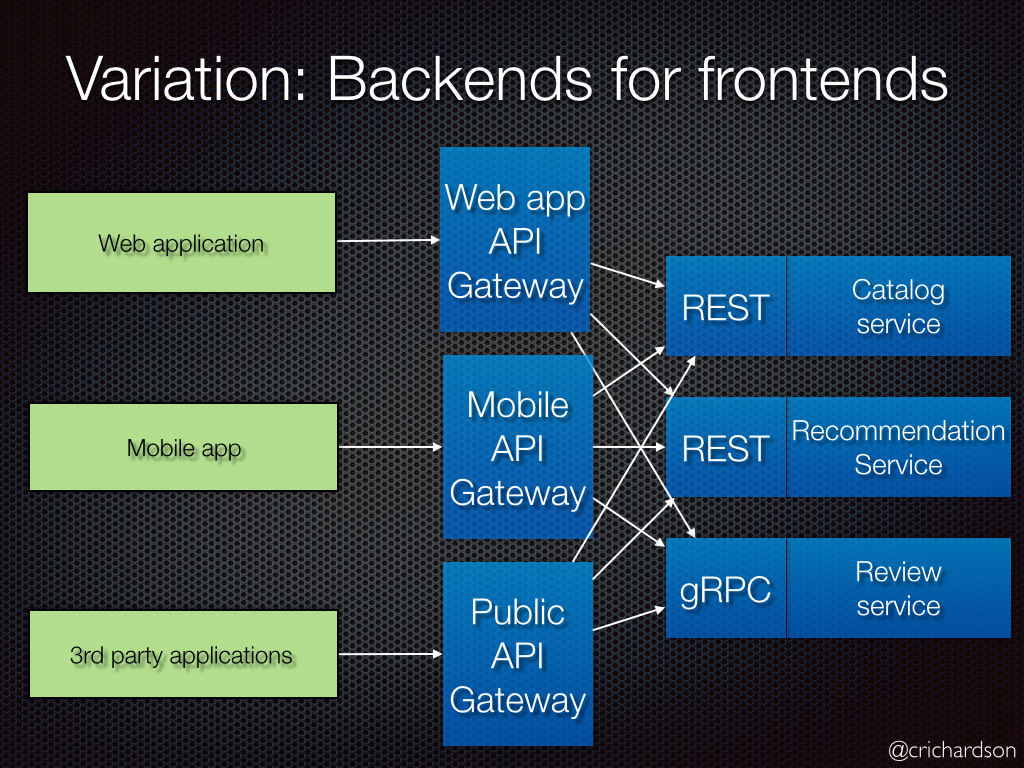Authorisation / AuthenticationClient (web/ mobile /server)cachingreporting , analyticsnetwork latency considertationscomposition, aggregationversioningprotocols / protocol translationsecurityquotas
An API gateway is a server that acts as a “front-end” for an API. It receives requests, enforces policies and forwards appropriate requests to the service. By virtue of being a proxy it can provide functionality to support authentication, authorisation, security, audit and regularity compliance. It helps insulate the client from the implementation details, deal with versioning and reduce the number of requests / round-trips by aggregating queries. There’s a great description of the pattern here.https://microservices.io/patterns/apigateway.html. Unfriendly Protocol for The Client, Poor User Experience Due To The Client Making Multiple Requests,Lack Of Encapsulation
Request Routing
API composition


Authentication — verifying the identity of the client making the request Authorization — verifying that the client is authorized to perform that particular operation Rate Limiting — limiting how many request per second from either a specific client and/or from all clients Caching — cache responses to reduce the number of requests made to the services Request Logging — log request https://miro.medium.com/max/875/1*QE985irHeuHXpEbNdUxIWg.png
Backend for Frontend (BFF) pattern
It is a variation of the API Gateway pattern. Rather than a single point of entry for the clients, it provides multiple gateways based upon the client. The purpose is to provide tailored APIs according to the needs of the client, removing a lot of bloats caused by making generic APIs for all the clients.
Using an API gateway has the following benefits:
** Insulates the clients from how the application is partitioned into microservices. Insulates the clients from the problem of determining the locations of service instances. Provides the optimal API for each client Reduces the number of requests/roundtrips. For example, the API gateway enables clients to retrieve data from multiple services with a single round-trip. Fewer requests also means less overhead and improves the user experience. An API gateway is essential for mobile applications. Simplifies the client by moving logic for calling multiple services from the client to API gateway Translates from a “standard” public web-friendly API protocol to whatever protocols are used internally The API gateway pattern has some drawbacks:
Increased complexity - the API gateway is yet another moving part that must be developed, deployed and managed Increased response time due to the additional network hop through the API gateway - however, for most applications the cost of an extra roundtrip is insignificant. One anti-pattern around API Gateways (as noted by Thoughtworks) is a tendency for the API gateway to grow in functionality to the point that its complexity outweighs the benefits. It’s still a SPOF and requires specialist skills to maintain.
Issues: How implement the API gateway? An event-driven/reactive approach is best if it must scale to scale to handle high loads. On the JVM, NIO-based libraries such as Netty, Spring Reactor, etc. make sense. NodeJS is another option. API gateway is deployed as a part of a business solution that is discoverable by the external clients handling north-south traffic(face external client), however, service mesh handles east-west traffic (among different microservices).
On the surface, it appears as though API gateways and service meshes solve the same problem and are therefore redundant. They do solve the same problem but in different contexts. API gateway is deployed as a part of a business solution that is discoverable by the external clients handling north-south traffic(face external client), however, service mesh handles east-west traffic (among different microservices).
A service-mesh offers consistent discovery, security, tracing, monitoring and failure handling without the need for a shared asset like an API gateway or message bus. Medium Link Article
· North/South communication refers to traffic flowing in and out of the data centre/network. · East/West communication refers to traffic flowing between devices within your data centre/ network.
API Management tools (such as API Gateways) really comes into the fore for North/South communication — when I’m bridging between the great big scary outside world and my internal software. Service mesh technology excels for East/West communication where I can use technology like mutual TLS to establish trust between components I own.
Service Mesh
**API Gateway **
- https://medium.com/ingeniouslysimple/what-is-an-api-gateway-8f0c4a1a1d39
- https://medium.com/easyread/api-gateway-part-1-7901ba703f9
- https://medium.com/easyread/api-gateway-part-2-7264ee5be187
- https://medium.com/dev-genius/microservices-design-api-gateway-pattern-980e8d02bdd5
- https://medium.com/@systango/what-is-api-gateway-why-i-should-use-it-34c5a55a6dfa


